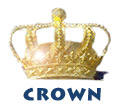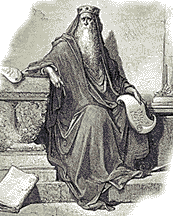
 There were two parts to
every ceremony in ancient Israel. The first part was conducted in the Temple
sanctuary with great pomp, with the royal guard standing around. The crown and
insignia were bestowed upon the king (investiture), and he was anointed with
oil and acclaimed. After the acclamation, all left the sanctuary and entered
the palace, where the king was enthroned and paid homage by the high officials.
We have two fairly detailed accounts of coronations in ancient Israel, that
of Solomon and Joash.[1]
Although some 150 years pass between the two coronations, the descriptions of
the two rites are so similar that scholars have concluded that they must represent
the established custom, at least in Judah. (In Solomon's account, investiture
is not mentioned, while homage is not mentioned for Joash; they do agree, however,
on the essential rite of anointing.)
 During
the Temple part of the ceremony, the priest handed the future king was the insignia
of the monarchy, i.e., the crown and the testimony The crown, a common royal
symbol in many cultures, was apparently a symbol of the ancient Israelite kingdom
as well.[2] During
the Temple part of the ceremony, the priest handed the future king was the insignia
of the monarchy, i.e., the crown and the testimony The crown, a common royal
symbol in many cultures, was apparently a symbol of the ancient Israelite kingdom
as well.[2]
"[Yehoyada the priest] then brought out the king's son, and placed upon
him the crown and the insignia. They anointed him and proclaimed him king; they
clapped their hands and shouted "Long live the king!" (II kings 11:12).
The Hebrew word used in this verse for crown and insignia are nezer and
édut, respectively. Scholars agree on the meaning of nezer:
it is the diadem or crown, which is the royal emblem par excellence. The word
édut, however, is more difficult: while meaning literally "testimony"
or "solemn law" it is sometimes corrected to s'adot meaning "bracelets." And
in fact, Saul's diadem and bracelets, which would have been royal insignia,
are brought to David.[3]
Nonetheless, given the many biblical sources in which the word "testimony" (édut) is used to denote covenant, law and status;[4] this
second item must probably have been a sort of protocol — either a religious
document kept in the Temple, affirming the new king's divine sonship and power
(and thus legitimizing his rule), or a royal document listing
the conditions incumbent upon him during his reign.
Father Roland de Vaux, in his scholarly work Ancient Israel (1957),
compares this testimony to that mentioned in Egyptian enthronement rites. The
Egyptian
protocol was supposedly written by the hand of god: Thutmoses III says: "He
has put my diadem on me and established my protocol." This is an excellent
parallel to the verse in II Kings in which the new king of Judah is given a
similar "testimony" affirming his adoption by God.
The anointing the king with oil in the Temple by the priest and/or prophet
is mentioned also for Saul, David, Absalom, Joachaz and Jehu, and probably
took
place for all the kings of Judah and Israel. In this religious rite, the "coming
of God's spirit" indicates that the king, as a consecrated person, shares
in the holiness of God and is thus inviolable; anointing made the reigning
monarch
the Meshiah Adonai — God's Appointed One.[5]
(Anointing was not a rite peculiar to Israel, and probably existed in Canaan
before the establishment of the Israelite monarchy; the kings in Mesopotamia
during this period, however, do not seem to have been anointed.)
The acclamation involved the sounding of a horn or trumpet, as the people shouted "Long
live the king!"[6] — a sign that
they accepted the choice made by God. Besides the cry, there was cheering and
the singing of psalms in praise of the
new ruler, to the accompaniment of flute and trumpet.[7]
After the acclamation, all left the sanctuary and entered the royal palace,
where the new king took his seat on the throne.[8] The
expression "sitting on the throne," which marks the assumption
of power and the beginning of the king's rule,[9]
recurs in other Eastern cultures as well as in modern languages.
Finally, when the king had taken possession of his throne, the high officials
came to do him homage.[10] This homage, mentioned
only in the account of Solomon, probably took place at every accession. The
ministers made acts of obedience and the new sovereign
confirmed them in their offices. In a parallel Assyrian royal ritual, the officials
laid their insignia before the king, and then ranged themselves around him
in
arbitrary order, without regard for position. When the king said "Let every
man resume his office," each officer resumed his insignia and his place
in the hierarchy.
The king of Israel, though never deified in the religion of ancient Israel,
is nonetheless sanctified by his coronation and anointing. He is now deemed
empowered by God to perform religious functions, and in fact — many kings
do exactly that. David sets up the first altar for God in Jerusalem and conceives
the project of building Him a Temple, Solomon builds and dedicates
the temple, Joash publishes ordinances concerning the Temple and supervises
their enforcement.[11] The kings even perform
acts reserved to the priest — offering sacrifices and blessing the people
in the sanctuary.[12]
|
[1]
The coronation of King Solomon — I Kings 1:33-48.
The coronation of Joash — II Kings 11:10-20 [back]
[2] II Samuel 1:10; Psalms 89:40; Psalms 132:18. In Egypt,
it was the bestowal of the crowns and scepters of Upper and Lower Egypt
which made a man a Pharaoh. In Assyria, the crown and scepter were placed
on cushions in front of the god; the priest crowned the king and handed
him the scepter. The Israelite accounts of enthronement do not mention a
scepter, although they do mention some sort of insignia, given the king
by the priest. [back]
[3] II Samuel 12:30. [back]
[4] Ex. 31:18; II Kings 17:15; Psalms 19:8; Psalms 132:12.
[back]
[5] David, for example, refuses to raise a finger against
Saul because he is God's Anointed (I Samuel 24:7,11; II:26:9,11,23), and
he executes the man who had dared to lift his hand against the king (II
Samuel 1:14,16). [back]
[6] I Kings 1:34,39; II Kings 11:12,14; II Kings 9:13. [back]
[7] I Kings 1:40; II Kings 11:13-14. [back]
[8] I Kings 1:46; II Kings 11:19. [back]
[9] I Kings 16:11; II Kings 13:13. [back]
[10] I Kings 1:47. [back]
[11] II Samuel 24:25; II Samuel 7:2-3; I Kings 5-8; I Kings
12:26-33. [back]
[12] I Kings 8:5, 62-64; I Kings 9:25; II Kings 16:12-15;
II Samuel 6:18; I Kings 8:14; I Kings 8:64; II Samuel 6:14. [back] |
CROWN
Table of Contents
|